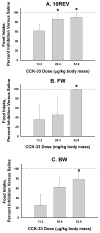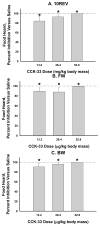Cholecystokinin-33 acutely attenuates food foraging, hoarding and intake in Siberian hamsters
- PMID: 20025915
- PMCID: PMC2837760
- DOI: 10.1016/j.peptides.2009.12.010
Cholecystokinin-33 acutely attenuates food foraging, hoarding and intake in Siberian hamsters
Abstract
Neurochemicals that stimulate food foraging and hoarding in Siberian hamsters are becoming more apparent, but we do not know if cessation of these behaviors is due to waning of excitatory stimuli and/or the advent of inhibitory factors. Cholecystokinin (CCK) may be such an inhibitory factor as it is the prototypic gastrointestinal satiety peptide and is physiologically important in decreasing food intake in several species including Siberian hamsters. Systemic injection of CCK-33 in laboratory rats decreases food intake, doing so to a greater extent than CCK-8. We found minimal effects of CCK-8 on food foraging and hoarding previously in Siberian hamsters, but have not tested CCK-33. Therefore, we asked: Does CCK-33 decrease normal levels or food deprivation-induced increases in food foraging, hoarding and intake? Hamsters were housed in a wheel running-based foraging system with simulated burrows to test the effects of peripheral injections of CCK-33 (13.2, 26.4, or 52.8 microg/kg body mass), with or without a preceding 56 h food deprivation. The highest dose of CCK-33 caused large baseline reductions in all three behaviors for the 1st hour post-injection compared with saline; in addition, the intermediate CCK-33 dose was sufficient to curtail food intake and foraging during the 1st hour. In food-deprived hamsters, we used a 52.8 microg/kg body mass dose of CCK-33 which decreased food intake, hoarding, and foraging almost completely compared with saline controls for 1h. Therefore, CCK-33 appears to be a potent inhibitor of food intake, hoarding, and foraging in Siberian hamsters.
Keywords: appetitive behavior; consummatory behavior; injection; satiety.
Copyright (c) 2009 Elsevier Inc. All rights reserved.
Figures




Similar articles
-
Neural and hormonal control of food hoarding.Am J Physiol Regul Integr Comp Physiol. 2011 Sep;301(3):R641-55. doi: 10.1152/ajpregu.00137.2011. Epub 2011 Jun 8. Am J Physiol Regul Integr Comp Physiol. 2011. PMID: 21653877 Free PMC article. Review.
-
Peripheral ghrelin injections stimulate food intake, foraging, and food hoarding in Siberian hamsters.Am J Physiol Regul Integr Comp Physiol. 2005 Mar;288(3):R716-22. doi: 10.1152/ajpregu.00705.2004. Epub 2004 Dec 2. Am J Physiol Regul Integr Comp Physiol. 2005. PMID: 15576659
-
Role of NPY and its receptor subtypes in foraging, food hoarding, and food intake by Siberian hamsters.Am J Physiol Regul Integr Comp Physiol. 2005 Jul;289(1):R29-36. doi: 10.1152/ajpregu.00853.2004. Epub 2005 Feb 10. Am J Physiol Regul Integr Comp Physiol. 2005. PMID: 15705801
-
Appetitive and consummatory ingestive behaviors stimulated by PVH and perifornical area NPY injections.Am J Physiol Regul Integr Comp Physiol. 2009 Apr;296(4):R877-92. doi: 10.1152/ajpregu.90568.2008. Epub 2009 Feb 4. Am J Physiol Regul Integr Comp Physiol. 2009. PMID: 19193934 Free PMC article.
-
Relationship between the concentration of cholecystokinin-like immunoreactivity in plasma and food intake in male rats.Physiol Behav. 1990 Dec;48(6):859-63. doi: 10.1016/0031-9384(90)90240-5. Physiol Behav. 1990. PMID: 2087518 Review.
Cited by
-
PYY(3-36) into the arcuate nucleus inhibits food deprivation-induced increases in food hoarding and intake.Peptides. 2013 Sep;47:20-8. doi: 10.1016/j.peptides.2013.05.005. Epub 2013 Jun 29. Peptides. 2013. PMID: 23816798 Free PMC article.
-
An effort toward molecular biology of food deprivation induced food hoarding in gonadectomized NMRI mouse model: focus on neural oxidative status.BMC Neurosci. 2018 Sep 24;19(1):59. doi: 10.1186/s12868-018-0461-9. BMC Neurosci. 2018. PMID: 30249177 Free PMC article.
-
Neuroendocrine regulation of appetitive ingestive behavior.Front Neurosci. 2013 Nov 15;7:213. doi: 10.3389/fnins.2013.00213. Front Neurosci. 2013. PMID: 24298235 Free PMC article. Review.
-
RF-amide related peptide-3 (RFRP-3): a novel neuroendocrine regulator of energy homeostasis, metabolism, and reproduction.Mol Biol Rep. 2021 Feb;48(2):1837-1852. doi: 10.1007/s11033-021-06198-z. Epub 2021 Feb 10. Mol Biol Rep. 2021. PMID: 33566226 Review.
-
Neural and hormonal control of food hoarding.Am J Physiol Regul Integr Comp Physiol. 2011 Sep;301(3):R641-55. doi: 10.1152/ajpregu.00137.2011. Epub 2011 Jun 8. Am J Physiol Regul Integr Comp Physiol. 2011. PMID: 21653877 Free PMC article. Review.
References
-
- Babcock AM, Livosky M, Avery DD. Cholecystokinin and bombesin suppress operant responding for food reward. Pharmacol Biochem Behav. 1985 May;22(5):893–895. - PubMed
-
- Baldwin BA, Cooper TR, Parrott RF. Intravenous cholecystokinin octapeptide in pigs reduces operant responding for food, water, sucrose solution or radiant heat. Physiol Behav. 1983 Mar;30(3):399–403. - PubMed
-
- Bartness TJ. Food hoarding is increased by pregnancy, lactation and food deprivation in Siberian hamsters. Am J Physiol. 1997;272:R118–R125. - PubMed
-
- Bartness TJ, Clein MR. Effects of food deprivation and restriction, and metabolic blockers on food hoarding in Siberian hamsters. Am J Physiol. 1994;266:R1111–R1117. - PubMed
Publication types
MeSH terms
Substances
Grants and funding
LinkOut - more resources
Full Text Sources

